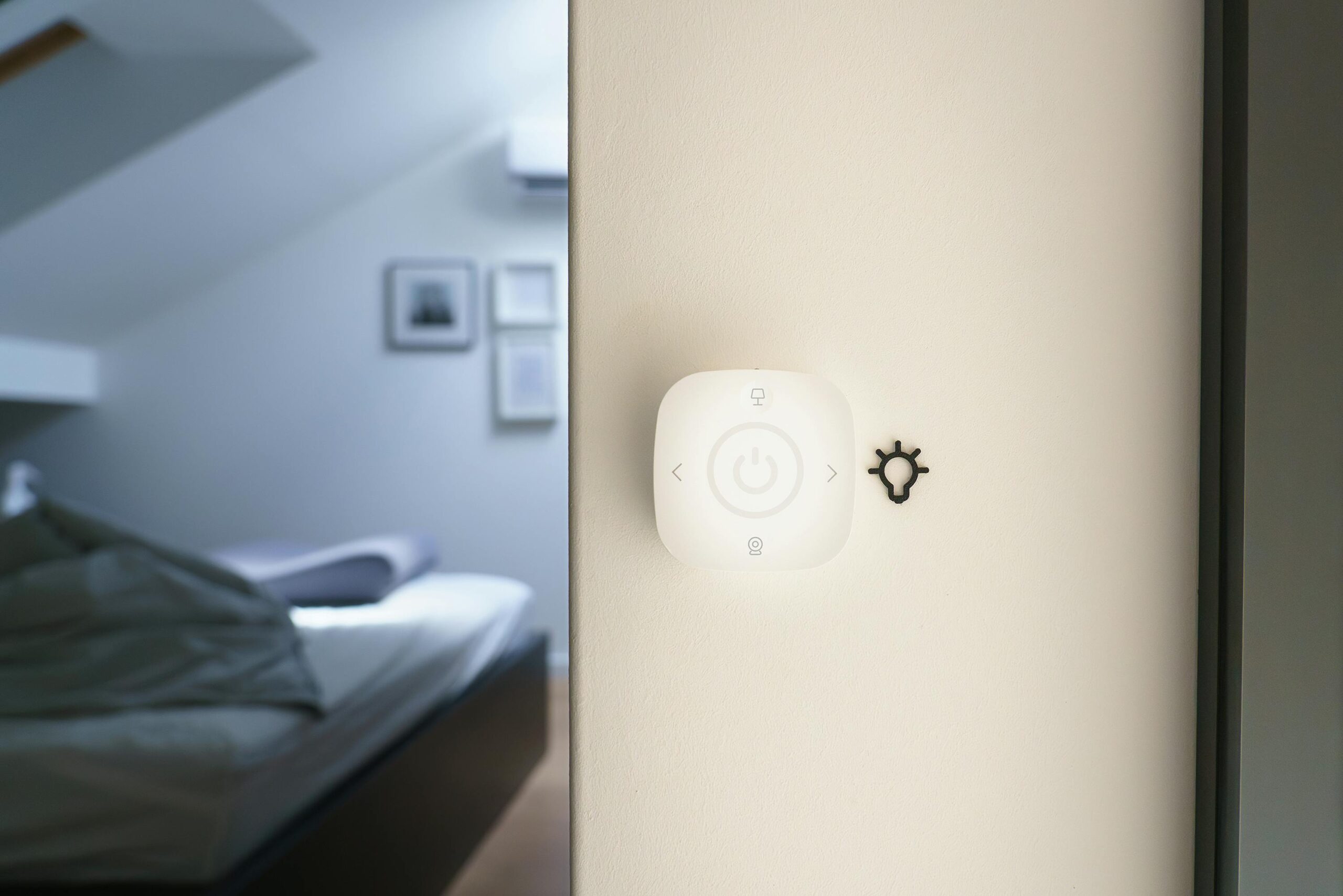A smart switch replaces a traditional light switch but adds connectivity, automation, and remote control features. It’s an easy and cost-effective way to bring intelligence to your home without replacing your entire lighting system.
Imagine walking into your home and the lights turn on automatically or telling your voice assistant to dim the lights without lifting a finger. This kind of convenience is possible thanks to a smart switch, one of the most essential building blocks in a modern smart home.
According to a 2024 Statista report, the smart home market is projected to reach over $231 billion by 2028, and smart lighting controls like smart switches are leading this growth.
In this guide, we’ll cover how smart switches work, their types, benefits, setup, and more.
Smart Switch Basics
A. What Is a Smart Switch?
A smart switch is a Wi-Fi or wireless enabled device that controls your home’s lights or appliances. Unlike traditional switches, smart switches can be controlled via smartphone apps, voice assistants, or even schedules and automation.
Key components include:
- Relay: Opens/closes electrical circuits
- Connectivity module: Allows remote communication
- Firmware: The software controlling automation and updates
B. How Do Smart Switches Work?
Smart switches operate using a small onboard microcontroller and relay system. When activated via app or voice, the relay is triggered to control the circuit.
Connectivity protocols include:
- Wi-Fi (most common for DIY setups)
- Zigbee/Z-Wave (used for mesh network smart homes)
- Thread (future-proof protocol supported by Matter)
- Bluetooth (short-range, basic features)
Smart switches either rely on cloud control (remote access via the internet) or local control (communication within your home network). Most offer both.
They typically work through a companion app and can integrate with voice assistants like Alexa, Google Assistant, or Siri.
Benefits of Using Smart Switches
- Energy Efficiency
- Turn off lights remotely
- Monitor usage and set timers to reduce waste
- Convenience
- Control switches using voice or smartphone
- Set schedules like “Turn off bedroom lights at 10 PM”
- Automation
- Group switches into scenes like “Movie Time” or “Good Morning”
- Enhanced Safety
- Vacation mode turns lights on/off randomly to deter burglars
- Shut off appliances remotely in case of emergency
- Smart Ecosystem Integration
- Sync with smart thermostats, locks, and sensors for full automation
Types of Smart Switches
- Single-pole – Controls one light from one location
- 3-way/4-way – Controls lights from multiple switches (e.g., hallways)
- Dimmer switches – Adjust light intensity
- Motion-sensor smart switches – Auto on/off based on movement
- No-neutral smart switches – Designed for older homes without a neutral wire
Popular Smart Switch Apps
1. Smart Life – by Tuya Smart
- Compatibility: Works with a wide range of smart switches from brands using Tuya firmware.
- Features:
- Remote switch control, scheduling, and automation
- Supports Alexa, Google Assistant, and Siri Shortcuts
- Scene and group controls
- Platforms: iOS & Android
- Best For: Budget-friendly smart switch brands like Gosund, Moes, and Treatlife
2. Google Home
- Compatibility: Works with all Google Assistant-compatible smart switches
- Features:
- Voice control, group control, routines
- Seamless Google ecosystem integration
- Platforms: iOS & Android
- Best For: Users heavily invested in Google smart devices
3. Apple Home (HomeKit)
- Compatibility: HomeKit-certified smart switches (e.g., Lutron Caseta, Eve)
- Features:
- Local and secure control
- Siri voice commands
- Privacy-first automations
- Platforms: iOS/macOS only
- Best For: iPhone/iPad/Mac users wanting tight Apple integration
Choosing the Right Smart Switch
Before buying, check:
- Compatibility: Do you have a neutral wire? What’s the box depth?
- Connectivity Protocol: Wi-Fi for ease, Zigbee/Z-Wave for large setups
- Design: LED indicators, tactile buttons, and touch options
- Brand Reliability: Choose brands with active firmware updates like TP-Link, Leviton, or Lutron
Installation & Setup
- Safety First: Turn off power from the main breaker
- Wiring Overview:
- Line wire (power in)
- Load wire (to the light)
- Neutral wire (white)
- Ground wire (green or bare)
- Pairing:
- Use your phone to pair with the switch via the brand’s app
- Connect to Wi-Fi or your smart home hub
- Testing & Troubleshooting:
- Label wires for future maintenance
- If lights flicker, check LED compatibility
Smart Home Adoption Growth (2020–2025)
- Over 50% of U.S. households are expected to have at least one smart switch by 2025
- Global demand for energy-saving smart lighting systems is growing rapidly
Automations & Use-Case Examples
- Sunrise/Sunset Schedules: Automatically turn lights off during the day
- Voice Commands: “Alexa, turn off all lights”
- Geo-fencing: Turn off lights when everyone leaves the house
- Security Mode: Lights flash if a motion sensor is triggered at night
- Power Usage Reports: Spot and replace high-energy appliances
Security & Privacy Considerations
- Regular Updates: Ensure your switch gets firmware patches
- Wi-Fi Security: Use strong passwords and WPA3 encryption
- Cloud Control: Choose brands with clear data privacy policies
- Network Isolation: Set up IoT devices on a separate VLAN or guest network
Cost, ROI, and Incentives
| Smart Switch Type | Price Range | Estimated Energy Savings |
|---|---|---|
| Basic Wi-Fi Switch | $20–$40 | 10–15% savings/year |
| Dimmer/Motion Variants | $35–$60 | 15–25% savings/year |
| Zigbee/Z-Wave Switches | $30–$70 | Ideal for whole-home use |
- Some electric companies offer rebates for installing energy-efficient devices.
- Payback period often under 1 year if paired with LED bulbs and smart routines.
Common Problems & Troubleshooting
- Connectivity Drops: Ensure strong Wi-Fi signal or switch to mesh network
- Old Wiring Issues: Use no-neutral smart switches
- Firmware Failures: Use trusted brands with auto-updates
- LED Flicker: Use compatible dimmable bulbs and adjust settings
Future of Smart Switch Technology
- Matter Compatibility: Ensures cross-brand device communication
- On-device AI: Switches that learn your habits
- Eco Designs: Lower standby power, recyclable materials
Conclusion & Next Steps
Smart switches bring real convenience, energy savings, and safety to any home. Whether you’re just starting or expanding your setup, smart switches offer an affordable, easy upgrade.
Start small: Try installing a smart switch in your bedroom or hallway.
FAQs
Q1. Do I need a neutral wire for every smart switch?
Not always. Some brands offer no-neutral options for older homes.
Q2. Can a smart switch work without Wi-Fi?
Some Zigbee/Z-Wave switches can function without internet via hubs.
Q3. Will a smart switch slow down my network?
Minimal impact, especially when on 2.4 GHz Wi-Fi or mesh systems.
Q4. Is it safe to install a smart switch myself?
Yes, if you turn off power and follow instructions. When unsure, hire a licensed electrician.
Q5. What happens if the internet goes down will my lights still work?
Yes, local control usually remains functional.
Disclaimer
This article is for informational purposes only. Installation of electrical components should be done with proper safety precautions or by a licensed professional. Always follow local electrical codes.



